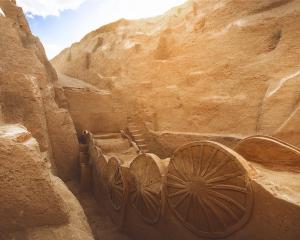Outer space does not have a monopoly on mystery. There are spaces closer to home that also boggle the mind.
I'm enamoured of space in all its relative definitions and manifestations. Explorations of space in all its relative positions, be it public, private, philosophical or even in a galaxy far far away, it is all fascinating.
Metaphysician Immanuel Kant viewed space as part of a systematic framework that humans use to structure all experiences.
So with this in mind, I would like to use this particular press space to discuss my own experiences of ''space'' relative to design, exploring how design has a relationship to space both literally and figuratively.
The relationship between space and design must begin with the golden record launched in 1977.
Attached to the facade of Nasa's Voyager 1 is the golden record, a communication device intent on representing humans on Earth.
Illustrative components featured as part of the record include a figure of a man and a woman.
Hilariously, there is conjecture as to why the original designer censored part of the anatomical representation of the woman's body in the illustration.
What is described as a ''short line'' was not included in the final rendering of the private parts of the female form.
This graphic sanitisation made the golden record woman a kind of Space Barbie in her genital-free visual appearance.
Of course an astronaut Barbie already exists, Mattel collaborated with Nasa in 2013 releasing Mars Explorer Barbie in all her pink glory, claiming the doll inspires girls to be adventurous and to always reach for the stars while firmly placing her stilettos on the moon.
Space Barbie: free to orbit space and in habitat earth, albeit without her ... short line.
Beyond some serious gender issues in relation to women in space, US president of the moment Jimmy Carter called the record a ''present'', while astronomer and all-round science powerhouse Carl Sagan used whimsy to describe the launch of the record, as a bottle being dropped into the cosmic ocean.
And commented on how the golden record might give some insight to extraterrestrials about the hopefulness of life on this planet.
All of my ideas about aliens from pop culture make me think that they might not have record players.
Zooming through the galaxy, the golden record has now reached interstellar space: a flying infographic of human civilisation.
I wait with anticipation to see how aliens might decipher the visual messages embedded on the record when intercepted.
Staring into another type of space in our aerial ocean of oxygen, a gravitational pull has made me reflect on signage in public spaces.
Never mind the space between the planets and the stars, there is some space junk right here in Aotearoa.
Public spaces have a plethora of graphic signage, situated and placed for their adoring audience, ready to tell them what to do and where to go.
A sign that captured the nation's attention recently for all the wrong reasons was the Ministry of Business, Innovation and Employment (MBIE) signage for the newly renovated Wellington head office.
This sign seemed to reveal a failure from ''mission control'' as costs drifted into a fiscal black hole to the tune of $67,339.
It seems a gross overspend on a piece of signage that does nothing to enhance the public space it sits within and highlights the hypocrisy in relation to what the Government will spend money on.
And if this is the sign that elucidates ''innovation'' in New Zealand I want a refund.
• However, there is a local design example in a public space that has become the centre of my universe: the Toitu Otago Settlers Museum facade.
The experience of space on the Toitu facade is one that concerns the space between letter forms, typographically referred to as kerning.
Typographers for centuries have laboured over the appropriate space each individual letter form has in a typeface in relation to another.
How do you know when a letter form is too close or too far away?
Therein lies a delicate art that has been established over time, which we too often take for granted.
Ellen Lupton, a prominent design writer and educator, regards her orthodontic treatment as a form of kerning and Adrian Frutiger, a typographer noted in Druckmarkt, a German magazine, that ''Typography must be as beautiful as a forest, not like the concrete jungle of the tenements ... It gives distance between the trees, the room to breathe and allows for life''.
The typographical space between the letter forms at Toitu are currently compromised and a far cry from a clean green forest.
They are, in fact, not natural.
On closer inspection, there is some serious space-related abuse.
The uppercase ''T'' is floating by itself like a wayward teenager embarrassed to be seen in public with its parents, while the ''i'' and the ''t'' look like they're dating, as they are clearly invading each other's personal space.
I have never been able to take these letter forms seriously.
Other designers I have spoken to have similarly been appalled, some incensed, ready to take to the streets and shout.
When I grumble about this to the vast majority of people, they look at me as if I've just said I've been abducted by aliens.
My response is, learn to kern and definitely don't look at the spaces in the letter forms on the building directly opposite Toitu either.
That is riot material.
If greater typographical consideration was given in this respect the visual experience could be proclaimed in the spirit of Neil Armstrong: One small step for (wo)man, one giant leap for design.
• Leigh Paterson is a lecturer in communication design at Otago Polytechnic.













